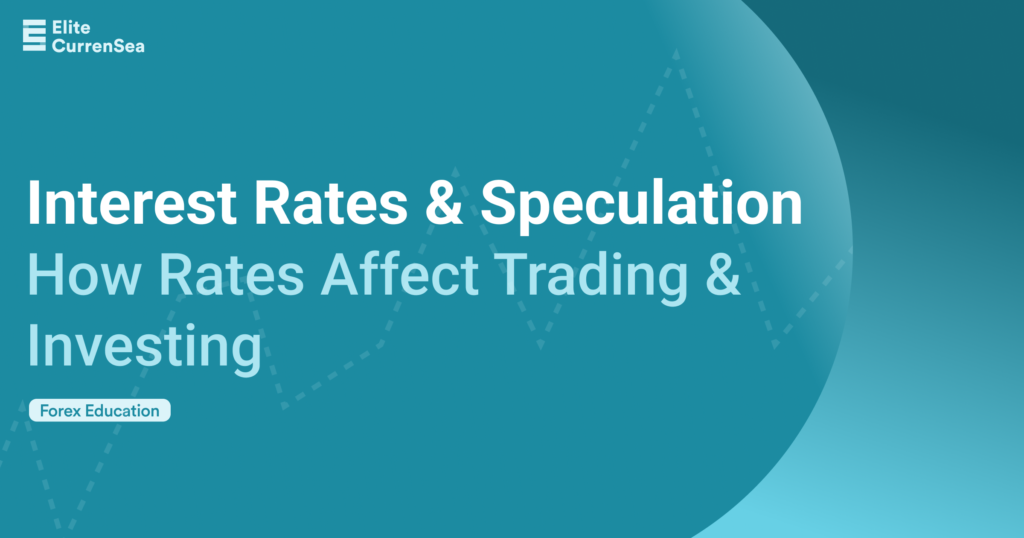How Interest Rates Affect Every Trade & Investment You Make

Most discussions about interest rates tend to be a bit dull, despite their fundamental importance in finance.
As an investor or trader, it is crucial to understand how interest rates impact the market. Interest rates are the fees charged when borrowing money and are normally expressed as an annual percentage of the amount borrowed.
Interest Rates Basics
Mortgages, credit cards, and overdrafts carry interest rates, and lenders receive interest payments, like the return on cash savings accounts. All interest rates are based on a country’s central bank’s underlying rate, also known as the “base rate,” which commercial banks are charged to borrow from each other or from the central bank.
Interest rates charged by financial institutions to borrowers are only slightly higher than the base rate. If the central bank increases the base rate, financial institutions are likely to raise their interest rates too.
Conversely, if the central bank lowers the base rate, interest rates decrease. Changes in interest rates can have a ripple effect on the economy, impacting stocks, bonds, and currency values, and even triggering a recession.
Central banks adjust interest rates to either heat up or cool down economic growth. Low interest rates make borrowing cheaper, leading to increased business activity and reduced unemployment. Low rates also encourage personal consumption, especially for high-value items such as cars and houses.
On the other hand, high demand for goods and services from a growing economy can lead to erratic inflation, making it challenging for households and businesses to save money or plan for the future. In this scenario, the central bank may raise interest rates to temper economic growth, making borrowing more expensive, discouraging people from spending, and keeping a lid on price rises.
The US central bank meets eight times a year to decide whether to raise, lower, or maintain rates, depending on which problem is bigger at the time – controlling inflation or unemployment. Adjusting rates can be controversial because it is not always clear what the right move is. The impact of changes in interest rates is significant in the market, and in the next session, we will discuss how they affect stocks and bonds.
Interest Rates & Bond Market
Changes in interest rates have a direct impact on bonds. If investors expect to be paid a higher interest rate next year than bonds currently offer, the value of the existing bonds goes down, and the prices of bonds currently in the market fall when interest rates increase.
The prices of short-term government bonds, which are low-risk loans, closely reflect changes in the base rate, and their prices fall when the base rate rises. Longer-term government bonds are also affected, but to a lesser extent.
Since government bond payments are as close as possible to risk-free returns, other riskier assets move in tandem with them. For instance, higher government interest rates force the prices of corporate bonds down until their yields are also high enough.
Interest Rates & Stock Market
The relationship between interest rates and stocks is a little more complicated. Generally, low-interest rates benefit businesses because payments on existing debt are lower. This frees up cash for investments, leading to higher stock prices.
However, if the economy becomes too hot, the central bank may raise interest rates to combat inflation. In this scenario, borrowing becomes more expensive, profits decrease, and stock prices fall.
Interest rates are likely to rise. Higher interest rates make it more expensive for companies to borrow money and can also reduce consumer spending, which can slow down the economy and company profits. This is why rising interest rates can cause stock prices to fall.
On the other hand, when interest rates are low, companies can borrow money more easily and cheaply, which can boost their profits and drive up stock prices. In addition, low interest rates can make stocks more attractive to investors, who may be willing to take on more risk in search of higher returns.
Overall, interest rates can have a significant impact on the performance of both individual stocks and the stock market as a whole. Investors need to pay close attention to changes in interest rates and adjust their portfolios accordingly.
Interest Rates & Forex
In the current global economy, investors have the option to invest their money in various countries. This creates competition between economies in terms of interest rates. If the United States has an interest rate of 1% and the United Kingdom is paying 5%, it doesn’t make sense for investors to invest in US bonds as they can get a better return in the UK with little additional risk. Smart investors will buy the British pound to purchase British bonds, increasing demand for the currency and raising its relative worth.
However, the relationship between interest rates and currencies is more complex, especially if high interest rates are accompanied by persistent high inflation in a country. In such a case, investors may worry about the erosion of their cash value over time and choose not to invest, pushing down the value of the country’s currency.
The impact of different currency values on individuals is significant. If a country’s currency value increases, purchasing products overseas becomes cheaper. On the other hand, the cost of importing products becomes more expensive. This imbalance can lead to declining exports and negatively affect businesses.
Furthermore, interest rate decisions of one economy can also affect another, particularly developing economies that often have debt denominated in dollars. If the dollar becomes more expensive, it becomes more costly for these economies to pay back their debt. In order to maintain stability and prevent overseas investors from withdrawing, these economies may increase their interest rates in line with the US.
How Interest Rates Affect the Economy
Now that you have a grasp of how interest rates can impact currency prices, let’s delve into the fascinating world of rate debates.
Is it always a straightforward decision when it comes to interest rates? Definitely not! The decision to raise or lower interest rates can be highly contentious, and economists can have heated debates about whether to hike or hold. To better understand these debates, let’s examine a case study: the US Federal Reserve’s interest rate decision in June 2019 and the debates surrounding it.
To provide some background, interest rates stood at 2.25-2.5% following four rate hikes in 2018 (the Fed sets a target range rather than an absolute number to make it easier to control rates). What was the argument for raising rates? US inflation, while not yet at the Fed’s target of 2%, was close enough to worry some experts. With stock markets soaring and unemployment at record lows, some investors were concerned about an overheating economy, and raising rates could help cool things down.
In case a US recession occurred in the near future – which most forecasts indicated was due in the next couple of years – having the flexibility to lower high interest rates would be advantageous.
After all, a significant reduction in interest rates helped revive a struggling economy in 2008. If interest rates were already low when a recession hit, there wouldn’t be much room to cut them and boost growth.
Why did people disagree? Some people believed that recessions could be tackled without major interest rate cuts. They argued that other tools, such as quantitative easing and government spending, could do the job (more on this in our Recessions Pack). Additionally, with inflation below the target, they claimed that a rate hike was unnecessary.
In reality, many, including the US president, advocated for a rate cut in June. They highlighted evidence of an economic slowdown and concerns that the US-China trade war could worsen growth. They also argued that a rate cut’s potential to stimulate investment could prolong economic expansion and avert a recession 🙌
So, what ultimately occurred? The ever-diplomatic Fed decided to keep rates unchanged. However, it suggested that a rate cut was on the horizon for later in 2019, despite the committee being split and no decision being made yet.
There you have it: you’re now an expert in interest rates. With the possibility of interest rate changes happening at least eight times per year, you’ll have numerous opportunities to apply your newfound knowledge.
Final Thoughts
In conclusion, while discussions about interest rates may seem dull and arcane, they are actually an essential part of finance that every investor needs to understand. Interest rates can have a profound impact on the economy, the stock market, and individual investments.
By keeping an eye on interest rates and understanding how they work, investors can make informed decisions that help them achieve their financial goals.
Safe Trading
Team of Elite CurrenSea 🇺🇦❤️











Leave a Reply